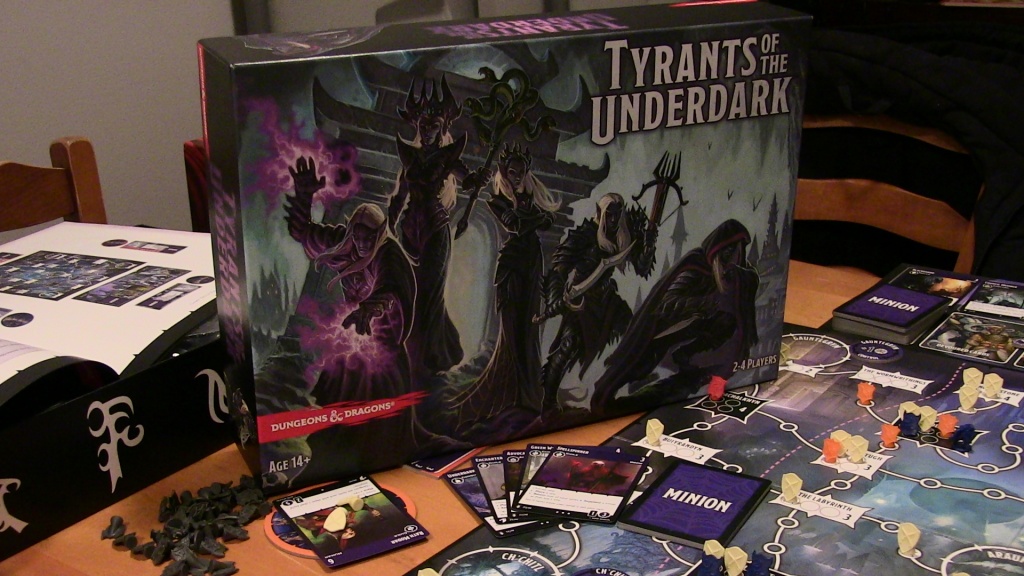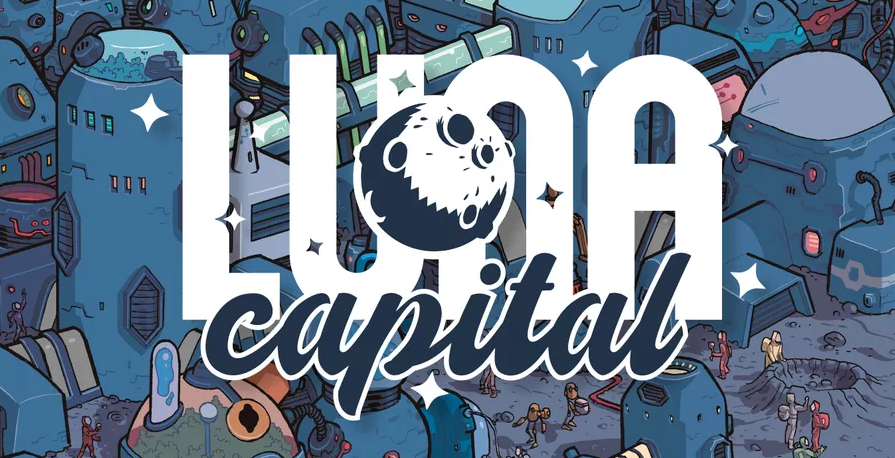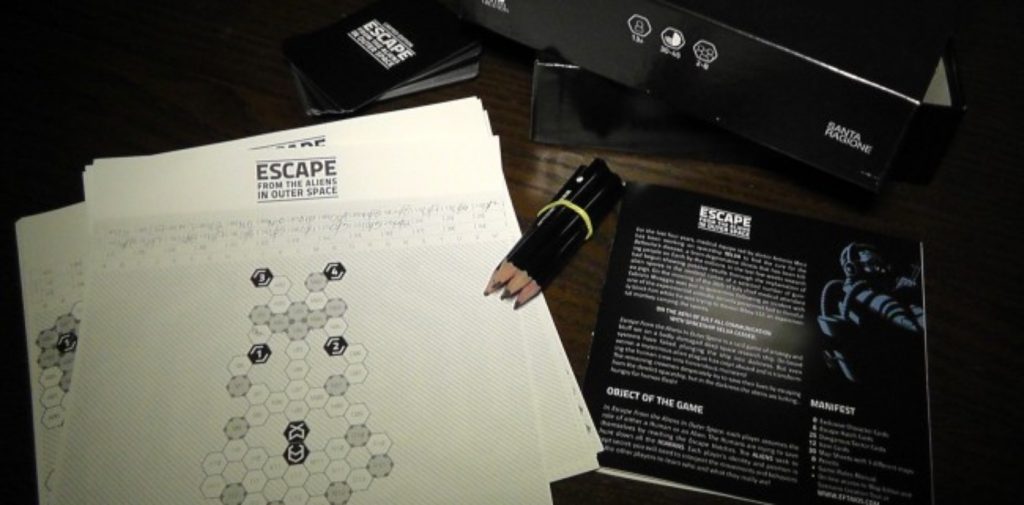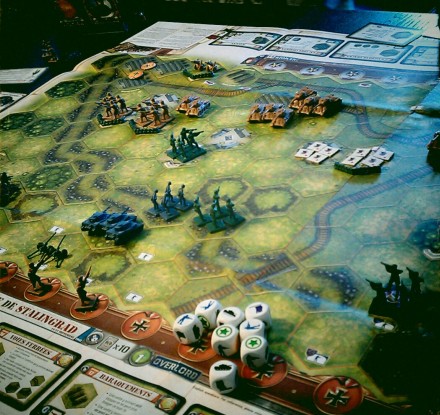Paul: I have a confession to make. I have a profound prejudice toward purple and it very much affected my first impression of Tyrants of the Underdark. When my review copy arrived, I was a man with plenty to do. I opened the box that evening, saw the almost monochrome palette of so much grey, black and violet, flipped through the manual and then put this in a cupboard.
Sure, it’s game set in the murky bowels of the Forgotten Realms, Dungeons & Dragons’ most famous setting, but did it really need to be so drab? I was squinting at the card art, groaning at the board and then, suddenly, some long-sealed vault in my mind was opened and a memory of the most monstrous mediocrity suddenly burst forth: Defenders of the Realm. Oh God. This is why I don’t play D&D board games. They lack all the spirit that the RPG inspires. “Tyrants of the Underpants,” I thought.
I was so wrong about Tyrants of the Underdark.
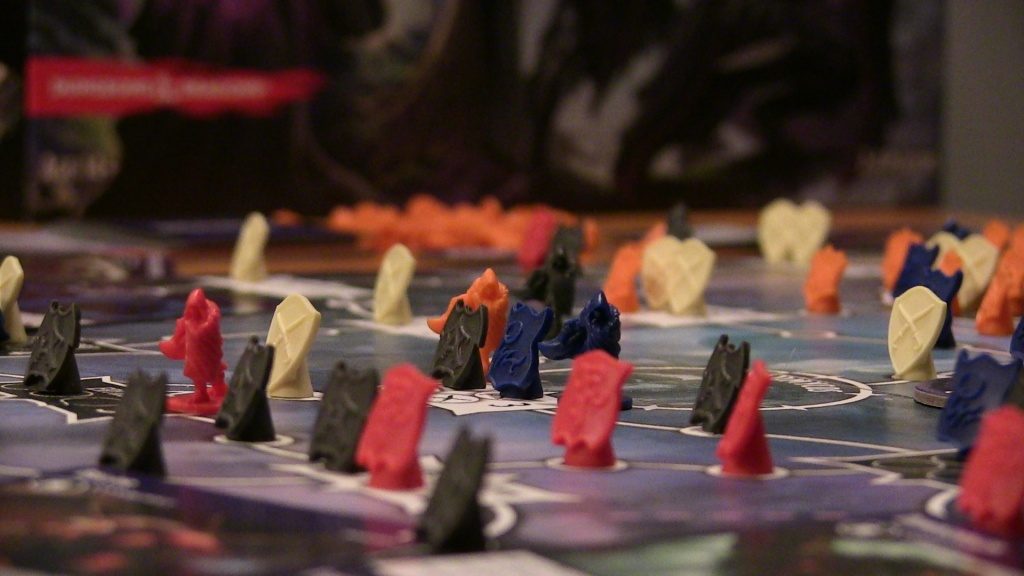
Okay, let’s first talk Drow. I’ll be honest with you, I know almost nothing about Drow. I do know that they’re are ashen-skinned elves who almost exclusively live underground in a spider-worshipping matriarchy where backstabbing is more important culturally than getting your five-a-day.
I also know that they name everything with the hope of scoring as many Scrabble points as possible (Drow Scrabble allows proper nouns). Most of all, I know that they live in a constant state of political turmoil that makes Game of Thrones look like The Waltons. You? You’re going to play a Drow house (as in organisation, not building – think Harry Potter, but everyone everywhere is Snape) and you’re going to try to control as much of the cavernous Underdark as you can.
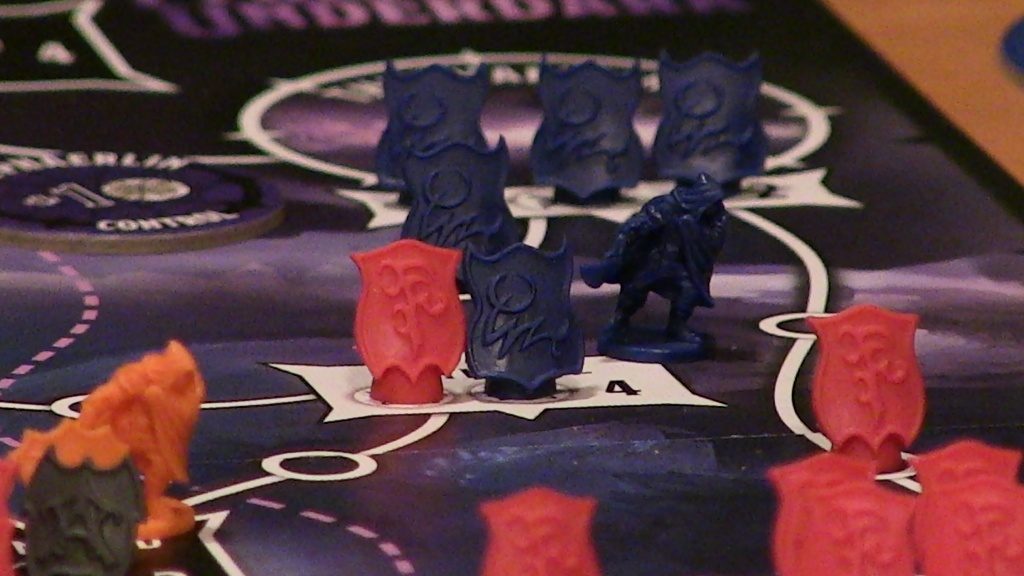
This game is a marriage made in Menzoberranzan, a smart fusion of two tried and tested game mechanics that we’ve seen used separately many, many times. The first is area control, where players are challenged to try to gain a commanding hold over as much of the board as possible, a task similar to you and your friends all trying to spread your own toppings onto the same slice of toast. Should you spread thin, but everywhere, fighting for everything? Or concentrate your confiture, to achieve at least some certainty of flavour dominance here and there?
The second is deck-building, where players begin with a small deck of cards that represent actions and powers, many of which can be played to buy more cards which expand their array of options. From the bud of a tiny deck, great and terrible things can grow, with better cards allowing you to play more cards that allow you to buy even better cards that see you snowballing your way to victory. If you make judicious choices.
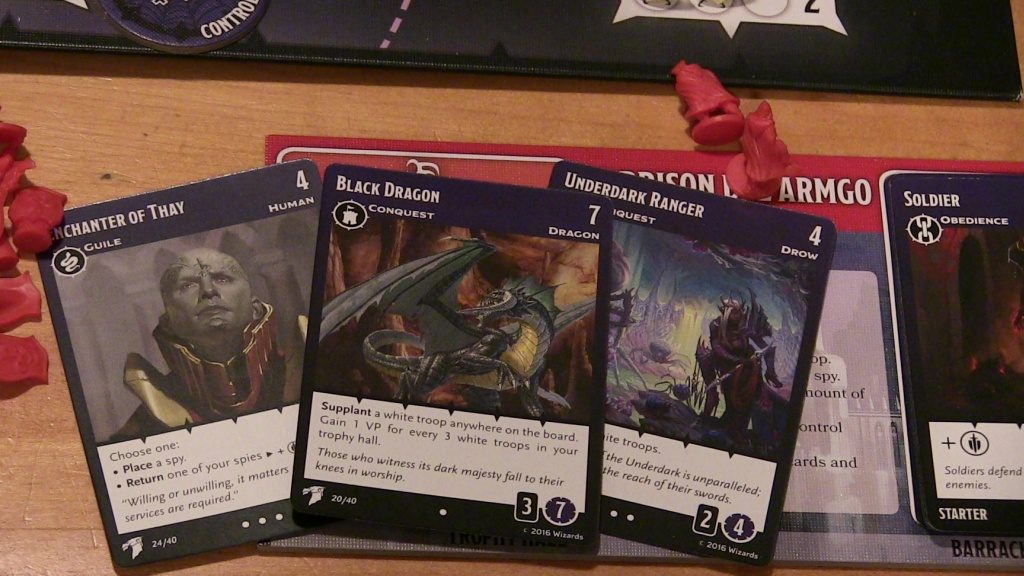
Now in theory, in theory, you could come up with countless cool new game designs if you combined two others that you liked. “How about Agricola meets Space Alert? You’re defending subsistence farmers against wolves and bears! In real time!” or “Let’s mix Mysterium with The Resistance! You’re trying to communicate who the traitor is through abstract imagery.” But really, ideas are ten a penny and it’s all about execution, about making that idea work, and Tyrants delivers.
See this below? This is the Underdark. I might be getting old, but I don’t remember its towering chambers and twisting passageways being quite so flat and featureless. Nevertheless, these caves still demand a-conquering and, as the game begins, they’ll also be seasoned with a peppering of white, neutral beasties. To run these folks out of town and assert your own, more colourful authority, you’ll have to start spending the game’s two different currencies: Influence and Power.
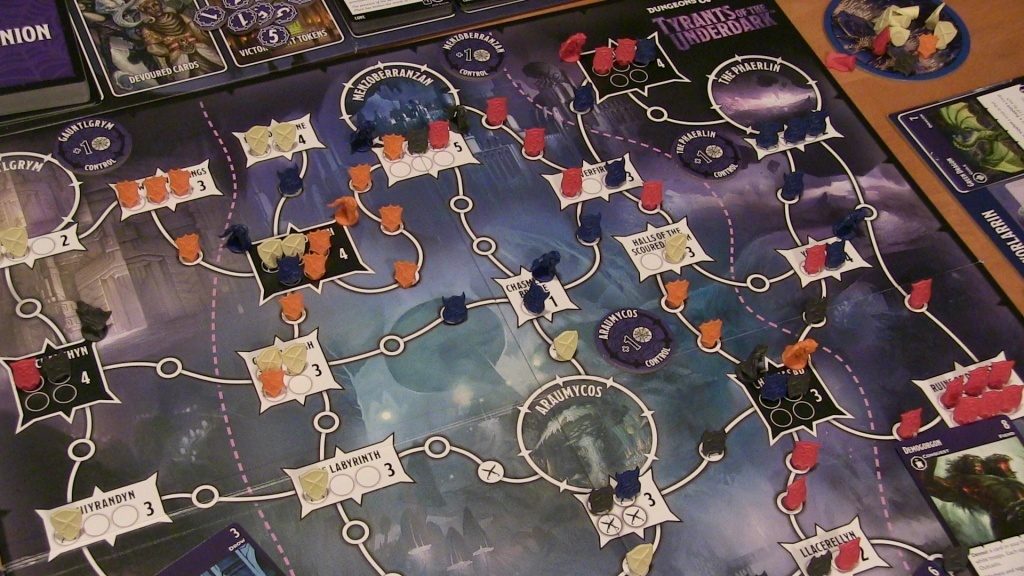
Like most deck-builders, you’ll start with just ten cards and draw a hand of five, giving yourself some combination of your house’s starting Nobles and Soldiers. The former wield Influence while the latter give you Power, each of which relates to one half of the game. Influence concerns cards, and you’ll spend it to buy more from an ever-changing central market, while Power allows you to exert muscle by deploying forces on the board or, sometimes, destroying someone else’s. You don’t carry anything over to your next turn, so what you draw is what you play.
Pretty quickly, it becomes apparent that most of the cards you can buy fall into one of three types: those that grant you more power, those that grant you more influence or, more often than not, those that allow you to perform a specific action. This is immediately something I like a lot about Tyrants. From the start, you’re weighing up whether you want to improve your ability to deploy troops or to diversify your hand and it’s rare that you’re simply buying a card because it has a bigger number than one you already hold. Sure, don’t get me wrong, some cards are as straightforward as that but, in a suitably Drowish way, most allow you to move enemy forces around, supplant them, assassinate them, promote other cards or drop spies onto the board.
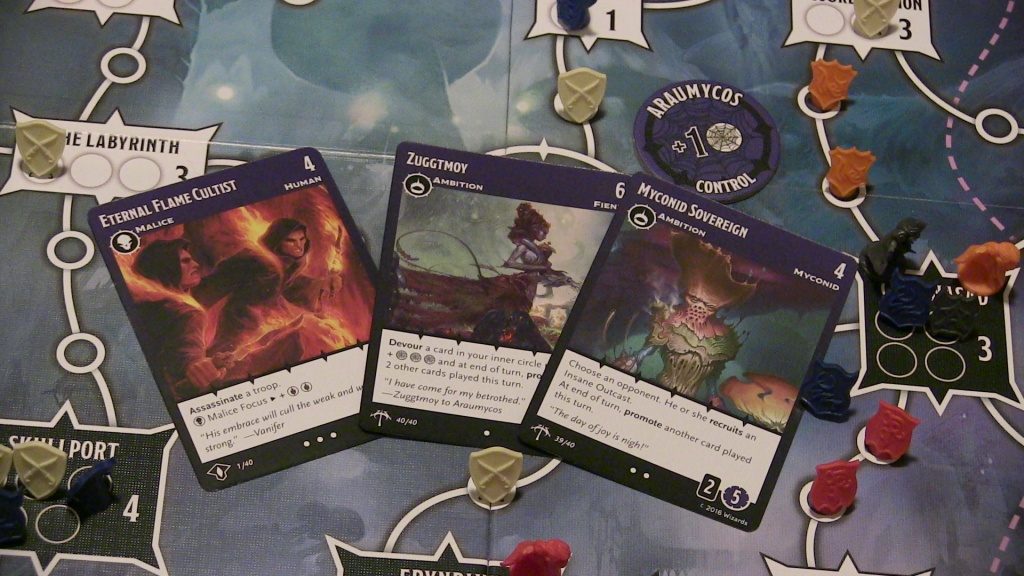
I’ll get to those promotions and spies in just a moment, but let’s talk about supplanting first. Outright fighting is expensive. It costs you power to deploy new forces and even more power to fight enemies. It’s slow. It’s tiring. Supplanting is far quicker as, providing you have at least some forces present, you deftly swap out an enemy piece for one of your own. However, this doesn’t work for those pesky neutral pieces and so there are other, specialist cards you can buy that will help you out there. But how many of those do you really need? The more neutral forces are cleared off the board, the less relevant they’re going to be.
It’s okay! This is the perfect time to talk about promotion. The challenge in many deck-builders is keeping your deck lean and efficient. The more cards you ram into it, the more cumbersome and unpredictable it becomes, so you inevitably eye cards that will allow you to discard others. Tyrants takes a much more merciful approach and lets you promote cards, taking them out of your hand and moving them into your throne room, a place where they can never be played again, but where their value increases significantly.
Y’see, at the base of each card is a victory point value that will contribute to your total at the end of the game. It’s great if you have a card that’s going to score you one point when it’s all over. Good for you! But what if, right, listen mate, listen, right? What if, right, it was worth THREE instead, but you couldn’t ever use it again? It’s a bit like that delayed gratification marshmallow exercise you do with two-year-olds. Except the marshmallows are murderers.
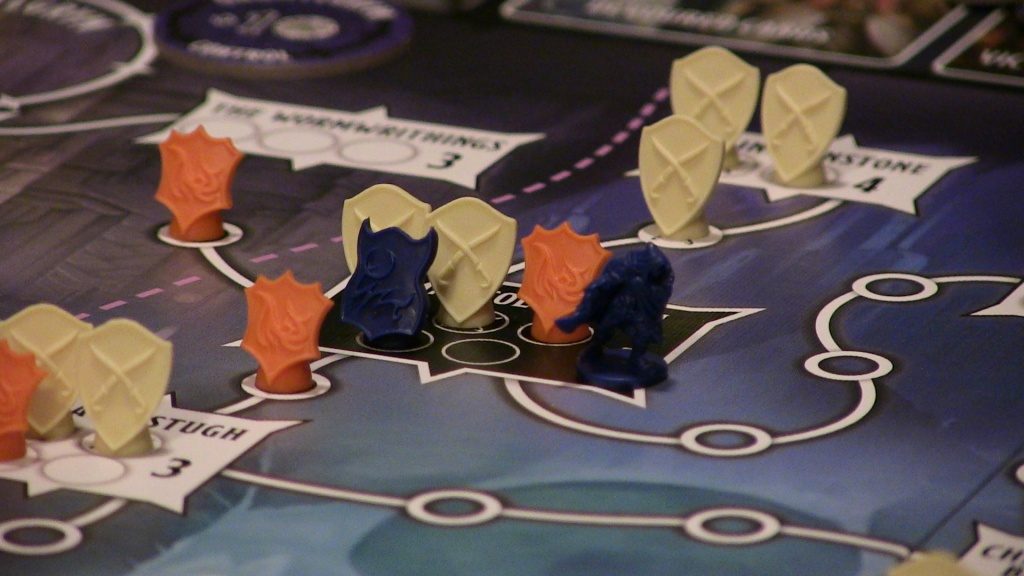
Spies! These guys are the seeds of your ambition and they’re responsible for keeping everyone on their elf-toes all game long. While your regular forces can only be deployed in a linear fashion, expanding outward from where previous forces already are and slowly snaking toward the next unpronounceable location through troll-infested tunnels (I actually have no idea if trolls live in the Underdark), they can also be deployed wherever you place a spy and those spies, well, they can be deployed anywhere. Just as long as you’ve bought the right card.
Sooner or later, you realise that your disappointment with this game’s presentation has melted away and you’re caught up in this constant interplay of careful deck curation and territorial expansion. As well as facing all the decisions you’d expect in both a deck-builder and area control game, you’re also repeatedly butting heads with other players, either trying to outmaneuver their deployments or baldly, boldly cutting them down wherever you feel threatened. You should, too, because as well scoring points for your cards and for areas of the Underdark you hold a majority in or occupy outright, Tyrants rewards you for your slaughter. It encourages you to fight.
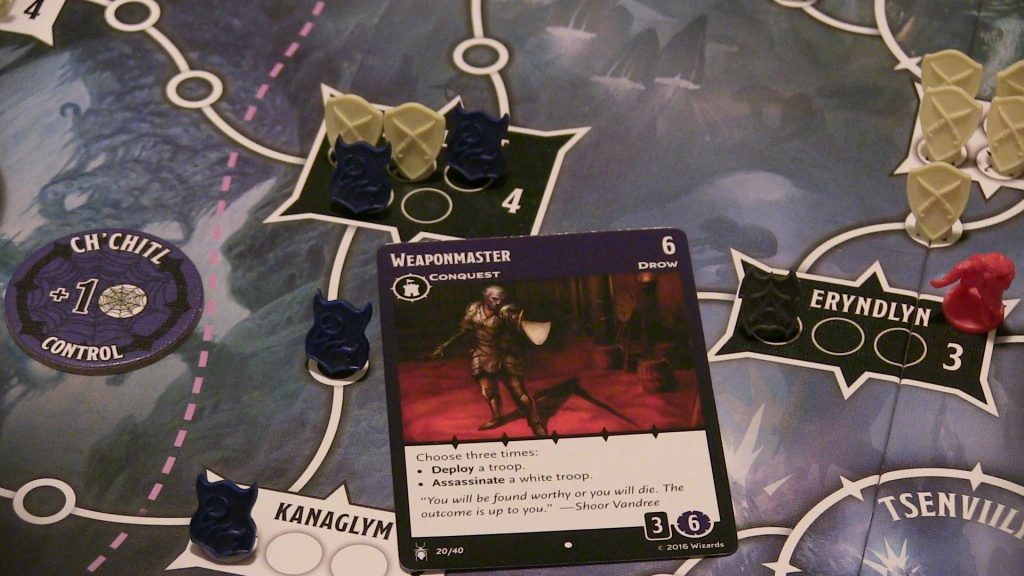
This could be a long and grinding battle of attrition, but it can be all over in an hour and a half or less. As soon as someone deploys their final piece, the current round of play concludes and everyone counts their cards, territories and war trophies. Cue some last-minute, frantic card promotion as disorganised Drow rush to shove dragons and wizards and generals into their throne rooms, but there’s never enough time. It’s all over! That’s Drow for now.
And let me tell you, I like it a lot. I like it an awful lot more than I expected to and I love how it has me continually assessing and reassessing not just where I’m going to pick my fights, but how. It’s up to me if I invest more in unsubtle Power or nuanced Influence, whether I promote a card after just one use or, hell, even just buy it with the sole intention of seeing it as nothing more than a throne room investment.
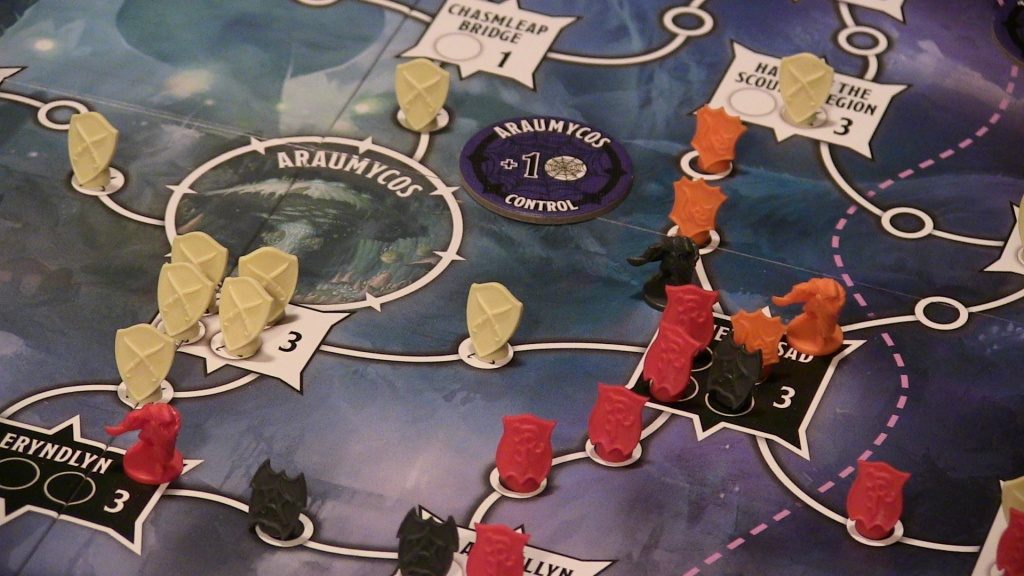
I still think it looks ugly as anything. All black, plush purple and other low colour tones which, combined with its many grimacing characters, make me feel more like I’m fighting for control of a suburban nightclub than the land of HIGH FANTASY. Two of the Drow houses are represented by blue and black, which don’t always stand out well enough against the board and, sometimes, even against each other, particularly in typical home lighting.
I wouldn’t expect to be paying seventy five bucks for it, either. “What?!” I hear you saying, in Drow disgust. “Seventy five you ess dollars? That seems… at least ten or twenty dollars more than many similar titles.” I have to admit that, actually, I’ve not seen Tyrants on sale anywhere at full price so far and it’s been discounted everywhere, but BEWARE. That is a premium price for a game that, while very good, can be such a damn strain on the eyes.
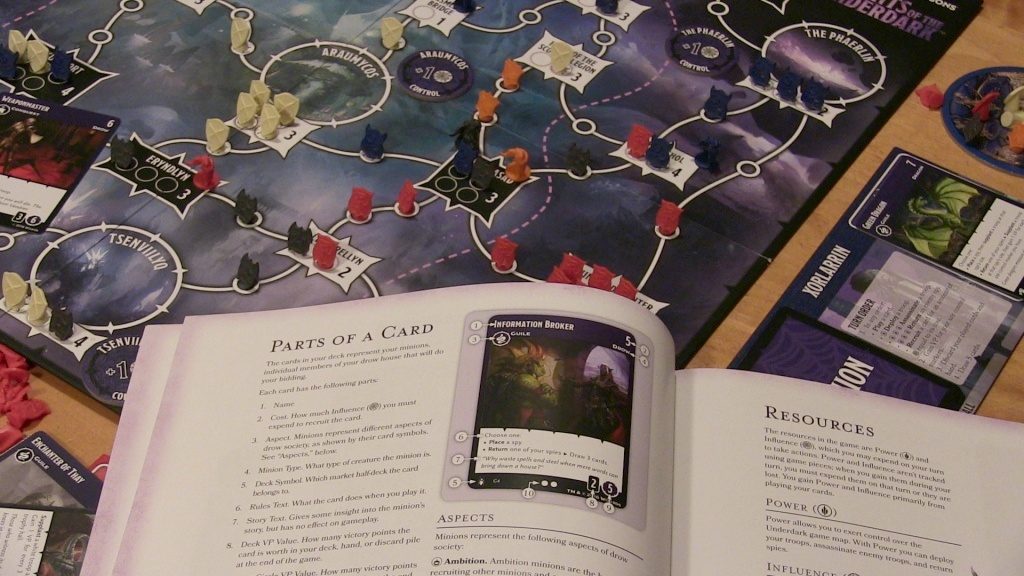
Here I am, working my way to a conclusion and realising I have very, very few criticisms of Tyrants of the Underdark. Those of you who are all about ruthlessly efficient deck-building will likely find that part too forgiving, as it’s hard to build a bad deck and easy to cast off poor purchases, but I’d argue that the point of the game is to battle your opponents and not your own draws. Those area control battles, also, are not the most mechanically marvellous and can turn into tit-for-tat exchanges, but again I’d argue that the onus is really on you where to pick your fights and to avoid getting bogged down in the same old stalemates.
In fact, none of it is mechanically astounding. Tyrants doesn’t sit at the bleeding edge of board game innovation and it’s not bringing much that’s new or profound to our tables, but it’s nevertheless very capably uniting two well-tested mechanics into a very entertaining and approachable combination. Not only do I firmly, warmly recommend it, writing this review makes me want to play it again RIGHT NOW GET OUT OF MY WAY.
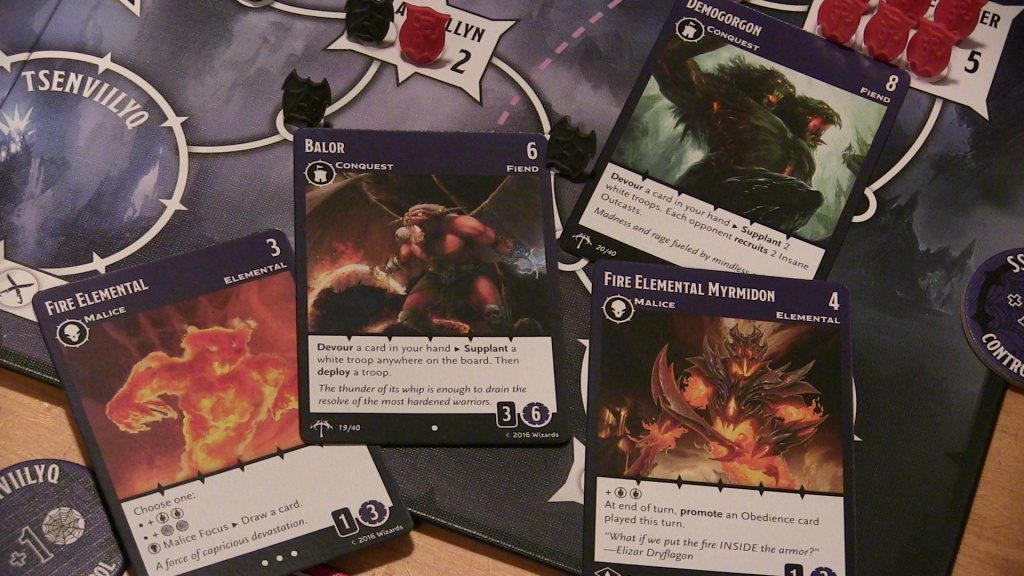
But not yet. There’s one more thing I want to tell you about and that’s the market card combinations. They’re formed by uniting any two of what the game calls “half decks” and each of these has a particular theme, say demons or dragons. The demons deck has a bunch of spies, but also you devouring cards for certain powers, which outright removes them from the game. The strange elemental deck introduces special Focus powers that combo certain card powers, encouraging you to buy cards of a similar type at the risk of narrowing your abilities.
As you might have guessed, more of these half decks are on their way in the imminent Aberrations & Undead expansion and I hope even more are to come. Tyrants is sleek, speedy and surprisingly sly. While I know this isn’t the highest bar to jump, it’s also the best Dungeons & Dragons board game we’ve ever had. When was I last this pleased to be wrong?

